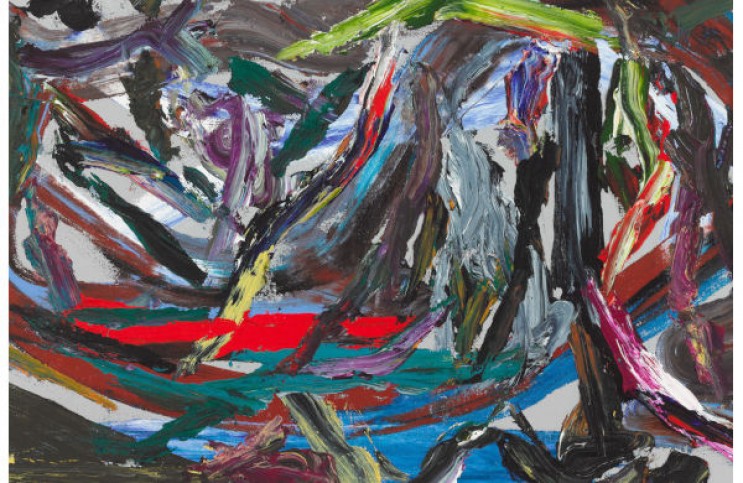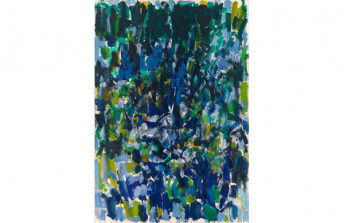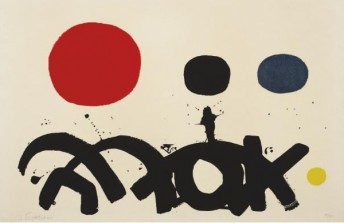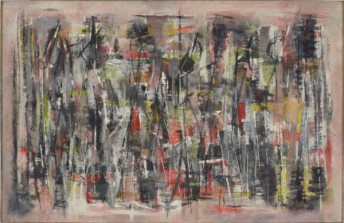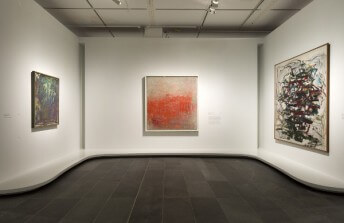Farewell to Eberhard Havekost
Jul 10, 2019
On 6 June, the German Press Agency (dpa) reported the death of German painter Eberhard Havekost at age 52. His gallerist, Frank Lehmann, owner of Galerie Gebr. Lehmann, was quoted as saying he was “deeply shocked, his death came so suddenly.” No cause of death has yet been revealed. Havekost was a professor of painting at the Düsseldorf Art Academy since 2010, and was considered by many a leading voice in German contemporary art. His work blends the theoretical and visual strategies of abstraction and figuration, revealing fluctuating boundaries between the two. Some parts of his oeuvre can be described as overtly contemporary, featuring images and text relating directly to the Internet age. Others, however, reveal an almost nostalgic reverence for the aesthetic positions and cultural tendencies of the 20th Century. For example, “Ghost 2” (2004) and “Wesen” (2008) both prominently feature starkly contemporary images of a hoodie, the iconic clothing of both tech culture and urban street culture—one showing a disheveled youth dressed in a hoodie and baggy sweatpants; the other showing en empty hoodie that retains a human structure. Works like “Schöner Wohnen B12” (2012), meanwhile, reference Minimalism, while “Märchenwald” (2013) mimics the paintings of Second Generation Abstract Expressionist artists like Joan Mitchell. Part of what gave Havekost his appeal was the space he occupied between irony and sincerity. It was often unclear whether he was poking fun at our age or embracing its ambiguity. One thing that was always evident was his talent for handling paint, and his eye for unmistakably current compositions. Aware that he was caught between the Information Age, when data drove every conversation, and the Age of Imagination, when creativity is once again becoming prized, Havekost had the rare ability to channel the aesthetic zeitgeist of the transitional age between the two.
A Few Good Paintings
One of the best tributes we can offer a painter is to simply talk about a couple of their most effective works. The first Havekost work I remember seeing was an oil painting called “Transformers, B14” (2014). The rather large scale canvas (120 x 80 cm) showed an image of a smashed car. What stood out to me about the picture was not its subject matter, however, but a large, grey color field in the center of the composition. Figuratively, this color field represented the mashed in hood of the car. Formally, I saw it as a delightfully flat geometric form that seemed to illuminate the canvas from within, while at the same time thrusting outward, almost pushing a hand in my face. Several other geometric color forms appear throughout the composition, creating a vibrant abstract infrastructure. Additionally, I was (and still am) amazed by the texture of the sky above (or behind) the car. Havekost achieved an extraordinary range of surface qualities in this painting, with the muted, blurry quality of the sky bringing the rest of the hues and forms into sharp focus.

Eberhard Havekost - Transformers, B14, 2014. Oil on canvas. 47 1/4 x 70 7/8 inches (120 x 180 cm). Anton Kern Gallery. © Eberhard Havekost
My second favorite painting by Havekost is a comparatively small (63 x 43 cm), and comparatively simple portrait called “Soft Power.” The image is of a young child wearing a denim jacket and a ball cap. The perspective we see is what you might imagine your phone sees when you take a selfie from underneath your face. That is why the picture at first appealed to me when I first saw it, because it looked so much like thousands of pictures I have seen on my Instagram feed. But the painting was painted in 2002. The first iPhone was not released until 2007, and Instagram did not exist until 2010. This image does not show what I thought it showed. It shows the quiet toughness of a child whose eyes are lost in shadow. Perhaps the child has knocked someone to the ground and now hovers over them; or perhaps the child is bending down to lend someone a hand. The personal aspects are lost in what has become an all-too-common contemporary perspective, making the painting more enigmatic now than when first painted. Abstractly, I love the two circular elements in this painting—one on the hat (which resembles a Kenneth Noland target) and one on the jacket (resembling an Adolph Gottlieb Burst).
A Legacy Cut Short
Havekost was born in 1967 in Dresden, when the city was still in East Germany, a state of affairs not exactly conducive to an art career. Havekost fled to West Germany in 1989, just two years before the Berlin Wall fell, then after the wall fell he returned to Dresden to finish his art studies. In the 1990s, as the medium of photography began to become more ubiquitous with the rise of the Internet, Havekost became concerned with the translation of photographs into paintings. He appropriated images from the media and the broader culture, altered them as prints, and then translated them into paintings. This process for him was partly an attempt to understand the difference between one medium (photography) that essentially captures an edited segment of reality, and another medium (painting) in which the artist must make intentional choices to construct every centimeter of the image.
As the 2000s went on, Havekost moved beyond his initial interests and his style evolved to a point where he no longer was interested in the subject matter or content of his pictures. Something about his analyses gave him more respect for the abstract qualities of the deconstructed pictorial field. In recent years, his paintings seemed to be less loaded with social or conceptual content, and more loaded with subjective emotional potential. Havekost himself noticed this transformation, commenting, “Legibility is no longer so important to me today. I do not see the picture merely as a window to a world of ideas. The viewer should interpret.” It is unfortunate whenever an interesting artist dies before they have had the chance to fully pursue their work. What Havekost meant by “merely” is interesting to me, but we will not have the chance to learn what more he thought the picture could be.
Featured image: Eberhard Havekost - Märchenwald, 2013. Oil on canvas. Anton Kern Gallery. © Eberhard Havekost
All images used for illustrative purposes only
By Phillip Barcio
